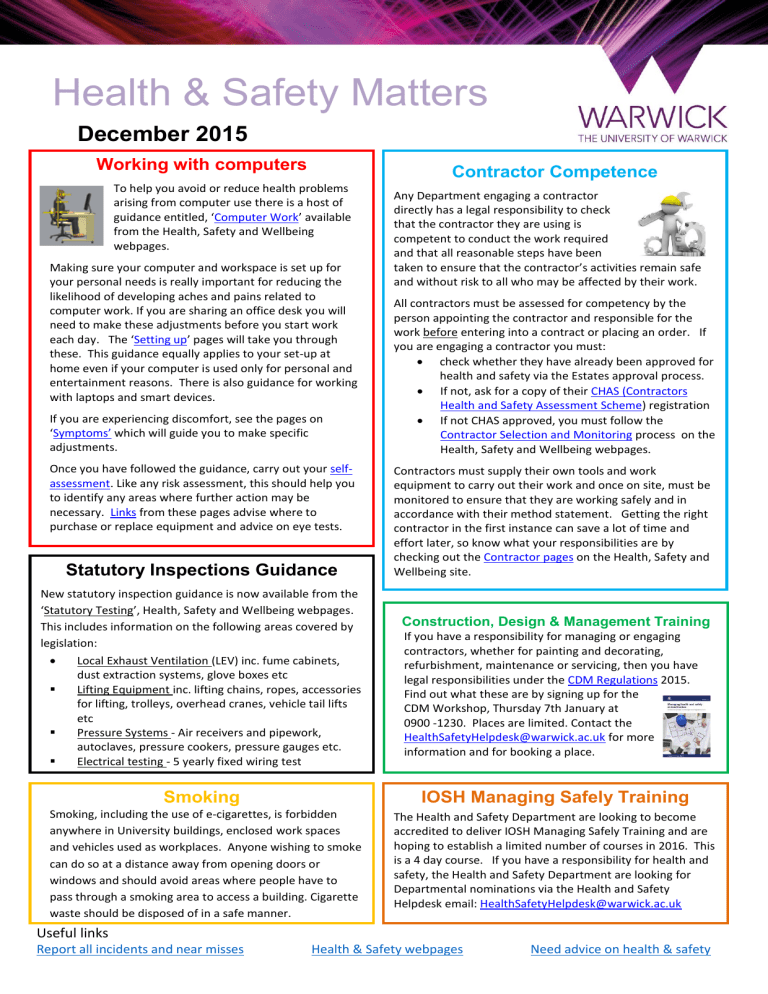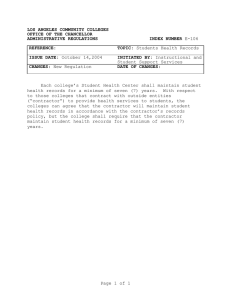Health & Safety Matters December 2015 Working with computers

Health & Safety Matters
December 2015
Working with computers
Contractor Competence
To help you avoid or reduce health problems arising from computer use there is a host of guidance entitled, ‘ Computer Work ’ available from the Health, Safety and Wellbeing webpages.
Making sure your computer and workspace is set up for your personal needs is really important for reducing the likelihood of developing aches and pains related to computer work. If you are sharing an office desk you will need to make these adjustments before you start work each day. The ‘ Setting up ’ pages will take you through these. This guidance equally applies to your set-up at home even if your computer is used only for personal and entertainment reasons. There is also guidance for working with laptops and smart devices.
If you are experiencing discomfort, see the pages on
‘ Symptoms’ which will guide you to make specific adjustments.
Once you have followed the guidance, carry out your selfassessment . Like any risk assessment, this should help you to identify any areas where further action may be necessary. Links from these pages advise where to purchase or replace equipment and advice on eye tests.
Statutory Inspections Guidance
New statutory inspection guidance is now available from the
‘Statutory Testing’, Health, Safety and Wellbeing webpages.
This includes information on the following areas covered by legislation:
Local Exhaust Ventilation (LEV) inc. fume cabinets, dust extraction systems, glove boxes etc
Lifting Equipment inc. lifting chains, ropes, accessories for lifting, trolleys, overhead cranes, vehicle tail lifts etc
Pressure Systems - Air receivers and pipework, autoclaves, pressure cookers, pressure gauges etc.
Electrical testing - 5 yearly fixed wiring test
Any Department engaging a contractor directly has a legal responsibility to check that the contractor they are using is competent to conduct the work required and that all reasonable steps have been taken to ensure that the contractor’s activities remain safe and without risk to all who may be affected by their work.
All contractors must be assessed for competency by the person appointing the contractor and responsible for the work before entering into a contract or placing an order. If you are engaging a contractor you must:
check whether they have already been approved for health and safety via the Estates approval process.
If not, ask for a copy of their CHAS (Contractors
Health and Safety Assessment Scheme ) registration
If not CHAS approved, you must follow the
Contractor Selection and Monitoring process on the
Health, Safety and Wellbeing webpages.
Contractors must supply their own tools and work equipment to carry out their work and once on site, must be monitored to ensure that they are working safely and in accordance with their method statement. Getting the right contractor in the first instance can save a lot of time and effort later, so know what your responsibilities are by checking out the Contractor pages on the Health, Safety and
Wellbeing site.
Construction, Design & Management Training
If you have a responsibility for managing or engaging contractors, whether for painting and decorating, refurbishment, maintenance or servicing, then you have legal responsibilities under the CDM Regulations 2015.
Find out what these are by signing up for the
CDM Workshop, Thursday 7th January at
0900 -1230. Places are limited. Contact the
HealthSafetyHelpdesk@warwick.ac.uk
for more information and for booking a place.
Smoking
Smoking, including the use of e-cigarettes, is forbidden anywhere in University buildings, enclosed work spaces and vehicles used as workplaces. Anyone wishing to smoke can do so at a distance away from opening doors or windows and should avoid areas where people have to pass through a smoking area to access a building. Cigarette
IOSH Managing Safely Training
The Health and Safety Department are looking to become accredited to deliver IOSH Managing Safely Training and are hoping to establish a limited number of courses in 2016. This is a 4 day course. If you have a responsibility for health and safety, the Health and Safety Department are looking for
Departmental nominations via the Health and Safety
Helpdesk email: HealthSafetyHelpdesk@warwick.ac.uk
waste should be disposed of in a safe manner.
Useful links
Report all incidents and near misses Health & Safety webpages Need advice on health & safety
1



